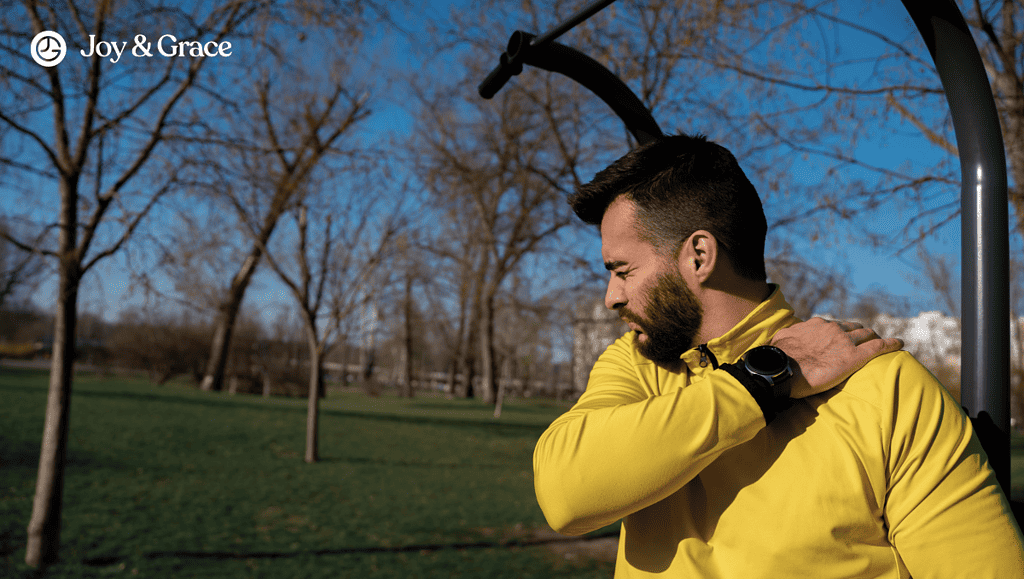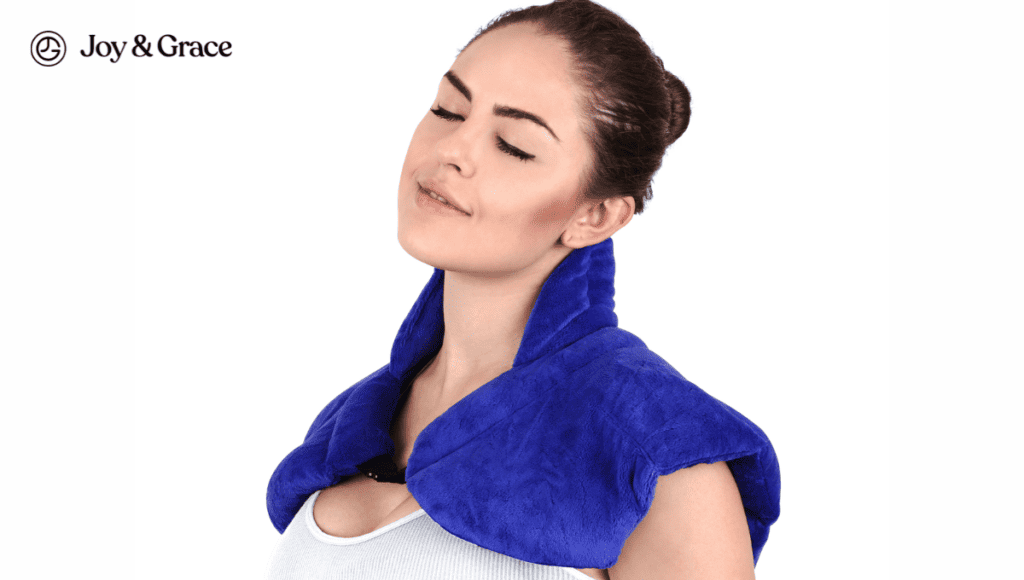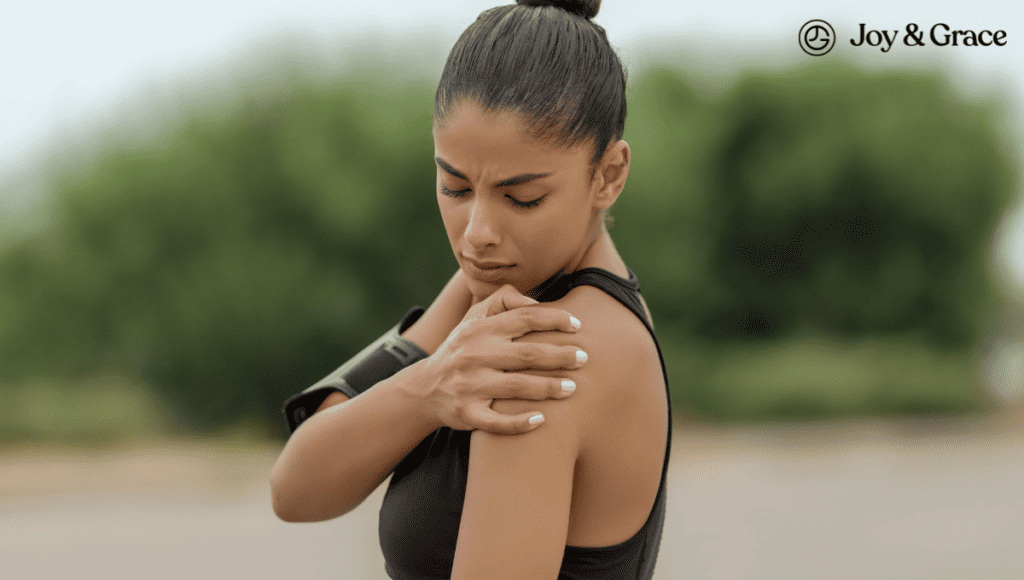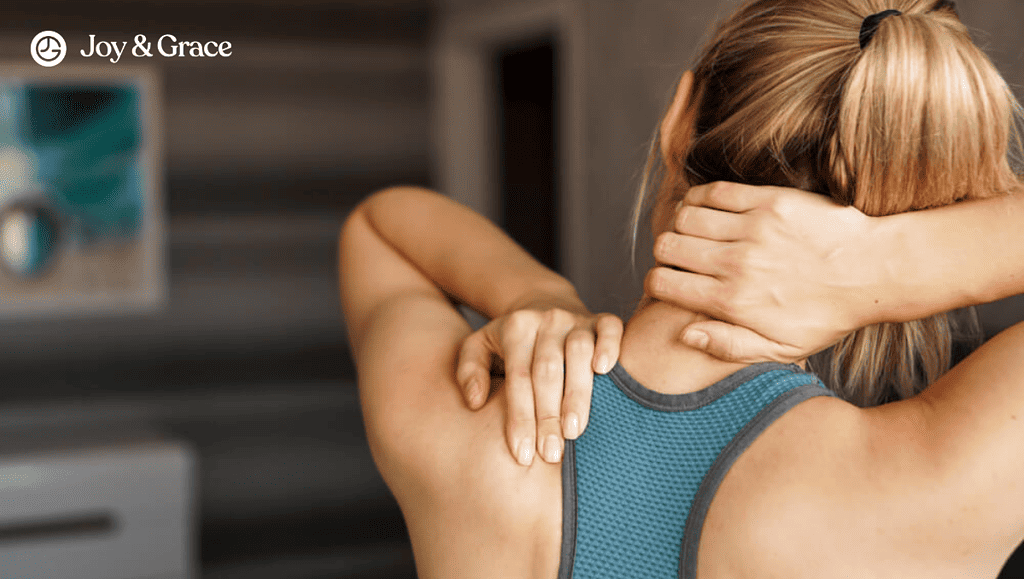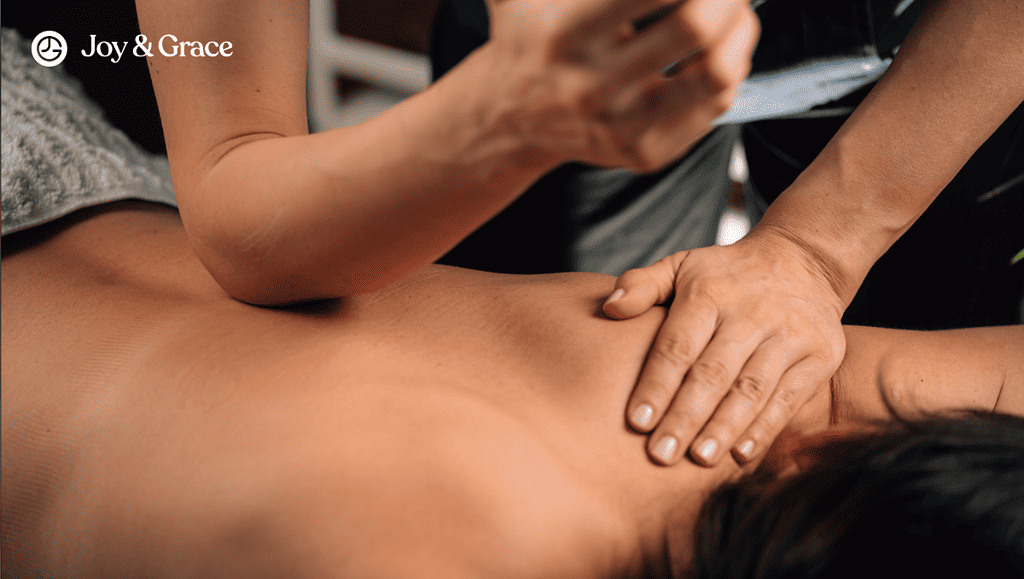Experiencing a sharp tug of pain in your shoulder when you attempt to pull can be concerning. You may not notice it, but we use pulling motions daily, from opening doors to putting on your favorite pair of jeans.
So, the unexpected jolt of pain can make everyday actions feel like a chore, and it's often hard to figure out what's happening. Is it a temporary glitch or an indication of a severe problem?
At Joy & Grace, we understand the anxiety and frustration you may be facing. We're here to explore common causes and potential solutions for this discomfort. Join us on this nurturing journey to relief and recovery because you deserve to reclaim the joy of pain-free movements.
Why Does My Shoulder Hurt When I Pull or Push?
Feeling pain in your shoulders when doing pulling or pushing motions is actually pretty common. It can result from various factors and is, most of the time, harmless and easy to manage.
This section will discuss the common, relatively benign causes of shoulder pain during pulling or pushing motions. True medical conditions and factors contributing to shoulder pain during exercise will be addressed later.
The most common causes of shoulder pain when pulling or pushing are:

- Poor posture
Yep, you read that right. Poor posture is one of the most common factors that can contribute to shoulder pain during pulling or pushing motions. We say that because many people are unaware of their posture and may unknowingly adopt positions that place excessive stress on the shoulders.
Over time, poor posture can lead to improper shoulder joint alignment, resulting in discomfort and pain when pulling or pushing. It's important to be mindful of your posture and make efforts to maintain proper alignment to minimize the risk of shoulder pain. - Muscle strain
If you didn’t know, some muscles are more involved in pulling, while others are more active during pushing. In the case of your deltoid (the muscle on your shoulders), it’s involved in both motions.
The front deltoid is activated when you push your arms forward or upwards. Meanwhile, the rear and side deltoids are activated when you pull your arms backward.
If you overuse your shoulders and deltoids, you may strain them. This may lead to shoulder pain when you pull or push your arms.
- Muscle imbalances
Aside from the deltoids, other muscles are activated when you push or pull. Now, imagine a group of people trying to lift a heavy object together, but some individuals are much stronger than others. As a result, weaker individuals may struggle to keep up, which can cause strain and discomfort.
In the case of your shoulder, when the muscles around it are imbalanced, it's like some muscles are doing more work while others are slacking off. This imbalance can create improper movement patterns, leading to pain when you pull or push.
What Conditions Can Cause Shoulder Pain When Pulling?
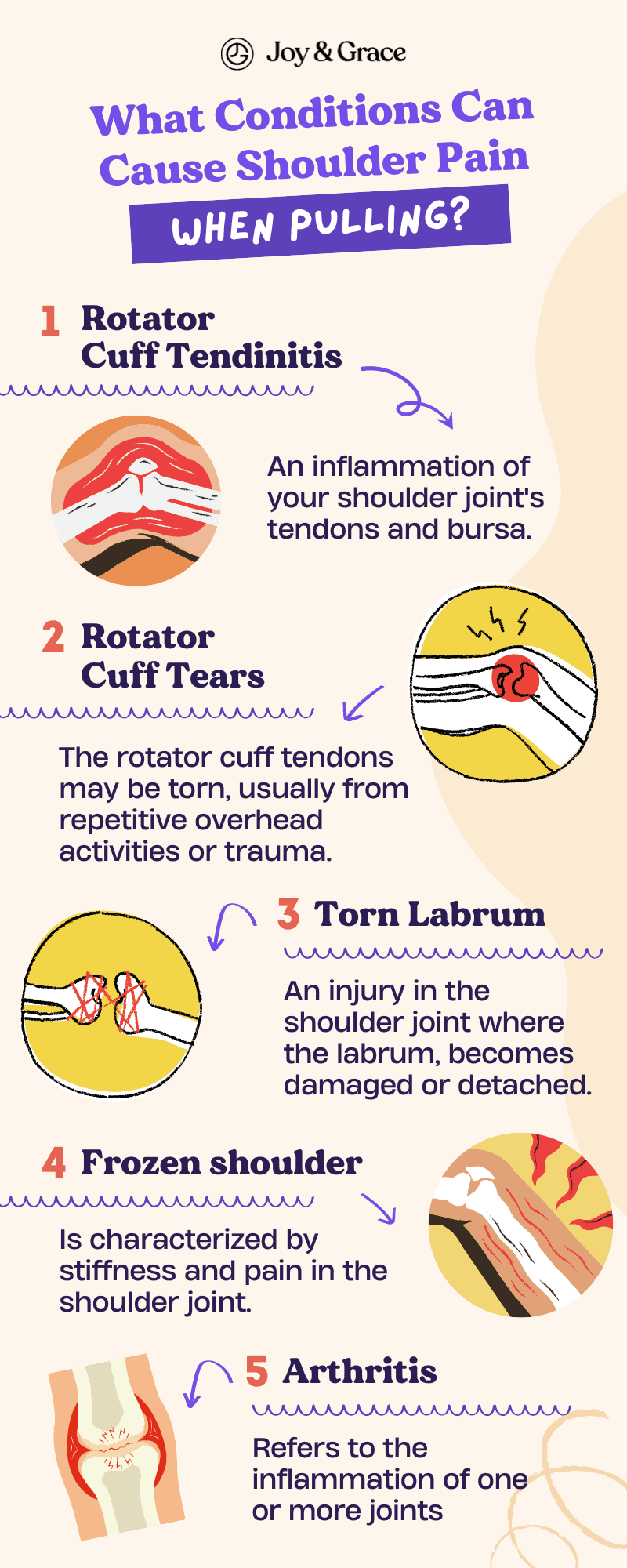
The pain can also be from serious conditions affecting your shoulder's tissues. One of the common conditions that may cause pain when pulling is a rotator cuff injury. A rotator cuff injury can be classified into:
- Rotator Cuff Tendinitis – An inflammation of your shoulder joint's tendons and bursa. The rotator cuff is a group of muscles and tendons that hold the shoulder joint together and enable you to move your arm in different directions. Meanwhile, bursae are tiny fluid-filled sacs that cushion the joints.
When these tendons are used repetitively or overloaded, they may become irritated and inflamed. Bursitis, shoulder impingement, and biceps tendonitis are just a few of the many names for this condition, but they all refer to the same thing. Shoulder impingement can cause pain during pulling exercises.
- Rotator Cuff Tears – The rotator cuff tendons may also be torn, usually from repetitive overhead activities or trauma. When this happens, it can result in pain, particularly when pulling or lifting objects.
Other possible conditions include:
- Torn Labrum – a torn labrum refers to an injury in the shoulder joint where the fibrous cartilage, known as the labrum, becomes damaged or detached.
- Frozen shoulder or Adhesive Capsulitis – is characterized by stiffness and pain in the shoulder joint. It occurs when the tissues surrounding the joint become thick and inflamed, leading to a reduced range of motion. Activities involving pulling or pushing may worsen the discomfort.
- Arthritis – Arthritis refers to the inflammation of one or more joints. Arthritis can affect the shoulder joint, leading to pain and limitations in movement. When pulling or pushing, the stress on the joint may worsen the symptoms.
It’s important to note that the factors mentioned in the previous section can also lead to the development of these conditions.
Why Does My Shoulder Hurt When I Do Pull Exercises?
Now, let’s discuss the factors behind shoulder pain solely while doing pull exercises.
As previously discussed, shoulder pain isn’t always due to a medical condition. Shoulder pain occurring only during a pull exercise may be due to factors related to how you perform the exercise. Let’s see what those factors are:
- Poor form and wrong technique – If you don't have the correct posture or do the exercise incorrectly, it can strain your shoulder joint and cause pain. Maintaining good posture and using the right muscles is important. Also, avoid pulling too hard or relying too much on your shoulder.
Pro Tip: We have a section on the proper form and technique of some of the main pull exercises just a bit below.
- No warm-ups – Skipping warm-up exercises before doing pull exercises can increase the risk of shoulder pain. Warm-ups help prepare your body by increasing blood flow and loosening the muscles. Without a proper warm-up, your shoulder might not be ready for the demands of the exercise, causing discomfort or injury.
- Overtraining or sudden increase in intensity – Doing too much can put excessive stress on your shoulder and lead to pain. Give your body enough rest and recovery between workouts, and gradually increase the intensity of your exercises.
- Wrong choice of equipment – The equipment you use during pull exercises can also contribute to shoulder pain. For example, using equipment that doesn't allow for a natural range of motion can cause discomfort. Choose equipment that fits your body mechanics and provides proper support.
- Delayed Onset Muscle Soreness (DOMS) – Sometimes, shoulder pain can be due to delayed-onset muscle soreness (DOMS). This is a normal response when your muscles are exposed to new or intense activities.
The main characteristics of DOMS pain are:
- The pain usually appears 24 to 48 hours after exercise
- Feels like general muscle soreness
- Disappears in a few days.
Gradually increasing the intensity of your exercises and allowing for proper recovery can help manage DOMS.
How Can I Prevent Shoulder Pain When Doing Pulling Exercises?
To prevent shoulder pain during pulling exercises, follow these simple tips:
- Warm-up
Before exercising, warm up your body to increase blood flow and prepare your muscles. Perform some light cardio exercises like jogging or cycling for 5–10 minutes.
- Maintain proper form and technique
During pulling exercises, it's crucial to maintain good form. Keep your back straight and your shoulders relaxed, avoiding rounding or slouching. This helps distribute the load evenly across your muscles and reduces pain and strain on your shoulders.
- Pull-ups:
- Start by hanging from a pull-up bar with your palms facing away from you. (Overhand grip)
- You can place your hands shoulder-width apart or slightly wider.
- Engage your core, squeeze your shoulder blades together, and pull your body up towards the bar. Focus on bringing your elbows to your hips.
- Keep your chest up and focus on using your back muscles to perform the movement.
- Once your chin is above the bar, slowly lower yourself back down to the starting position.
- Avoid swinging or using momentum to complete the exercise, as it reduces effectiveness and can increase the risk of injury.
- Lat pulldown:
- Sit down at a lat pulldown machine and adjust the thigh pads to secure your legs.
- Grip the bar with your palms facing away from you, slightly wider than shoulder-width apart.
- Lean back slightly and stick your chest out while keeping your core engaged.
- Pull the bar down towards your chest, focusing on squeezing your shoulder blades together. Do not flare out your elbows.
- Pause for a moment at the bottom of the movement. Then slowly release the bar back up to the starting position.
- Avoid using excessive momentum or leaning back excessively during the exercise.
- Barbell Biceps curls:
- Stand with your feet shoulder-width apart and hold a barbell with an underhand grip, palms facing forward.
- Keep your upper arms close and loose to your sides and elbows stationary.
- Slowly curl the barbell up towards your shoulders, focusing on squeezing your biceps.
- Pause for a moment at the top of the movement, then lower the barbell back down to the starting position in a controlled manner.
- Avoid swinging or using your back or shoulders to lift the weight. Keep the movement isolated to your biceps.
- Deadlifts:
- Stand with your feet hip-width apart, toes pointing forward, and the barbell on the ground in front of you.
- Bend down and grip the barbell with your hands just outside your knees, palms facing your body.
- Keep your back flat, chest up, and engage your core.
- Drive through your heels, straighten your legs, and lift the barbell off the ground while keeping it close to your body.
- As you lift, extend your hips and push your shoulders back, squeezing your glutes and engaging your hamstrings.
- Lower the barbell back down to the ground by reversing the movement, maintaining control throughout the descent.
- Avoid rounding your back or jerking the weight. Focus on maintaining a neutral spine and using proper lifting mechanics.
- Seated Cable Rows:
- Sit on a rowing machine with your feet flat on the footrests and knees slightly bent.
- Grab the handles with palms facing each other (neutral grip).
- Sit upright with your back slightly arched, shoulders relaxed, and core engaged.
- Pull the handles towards your body by squeezing your shoulder blades together and driving your elbows back.
- Pause for a moment at the fully contracted position, then slowly release the handles back to the starting position.
- Avoid using excessive momentum or leaning back during the exercise. Focus on using your back muscles to perform the movement.
- Engage your core
Strengthening your core can help stabilize your body during pulling exercises. Tighten your abdominal muscles and maintain a stable core throughout the exercise. This supports your upper body and prevents excessive strain on your shoulders.
- Gradually increase intensity
Gradually increase the intensity as your muscles get stronger and more conditioned. Avoid jumping into high-intensity exercises immediately.
- Seek guidance
If you're new to pulling exercises or have specific concerns about your shoulder, seeking guidance from a fitness trainer can help. They can assess your posture, technique, and individual needs. By providing personalized recommendations, they can help prevent shoulder pain.
- Choose the right equipment and grip options
Selecting the appropriate equipment for pulling exercises can make a big difference. Consider the following:
- Grip options
Different pulling exercises have various grip options. This includes:- Overhand
- Underhand
- Neutral grip
Experiment with different grips to find the most comfortable and puts the least strain on your shoulders.
- Resistance bands
Using resistance bands instead of weights can be helpful, especially for beginners or those with shoulder issues. - Equipment adjustments
Adjust the equipment to a suitable height and position that allows your shoulders to move through a comfortable range of motion. Properly aligning the equipment can minimize unnecessary stress on your shoulder joints.
- Avoid excessive weight
Use weights appropriate for your strength and ability. Avoid using excessive weight that causes you to compromise your form or strain your shoulders. Gradually increase the weight as your strength improves, always maintaining proper technique.
- Grip options
- Don't overdo it
Listen to your body, and don't push yourself beyond your limits. Overtraining or excessive repetition can strain your muscles and joints, including your shoulders. Allow your body enough time to recover between workout sessions to prevent overuse injuries.
- Stretch and cool down
Gently stretch to release muscle tension after your workout. Cooling down gradually brings your heart rate and body temperature back to normal.
- Rest and recover
Give your body enough rest and recovery time between workouts. Muscles need time to repair and rebuild after exercise. Adequate rest helps prevent overuse injuries and allows your shoulders to heal and strengthen.
Everyone is unique; what works for one person may not work for you. Listening to your body, being mindful of discomfort or pain, and adjusting your approach is essential.
Can I Still Do Pull-Ups With An Injured Rotator Cuff?
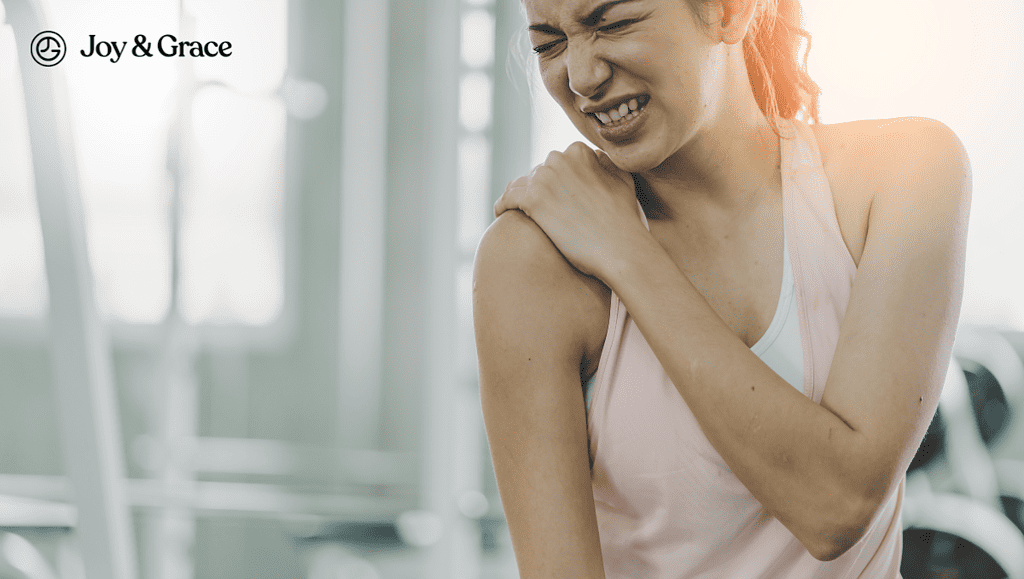
If you’re a gym rat, it may be tempting to continue doing pull-ups despite having an injured rotator cuff. But, unfortunately, you may have to rest this one out.
If you have an injured rotator cuff, pull-ups are generally not recommended until the injury has healed. Pull-ups can strain rotator cuff muscles, potentially worsening the injury and causing more pain.
It's best to consult with a healthcare professional who can assess your specific injury. They can provide guidance on when it's safe to resume pull-ups or recommend alternative exercises that are safer for your shoulder.
Remember to give your body the time it needs to heal. Do not rush.
What Can I Do To Relieve Shoulder Pain From Pulling?

- Improve posture
Poor posture can contribute to shoulder pain. Practice maintaining good posture throughout the day. Keep your shoulders relaxed, avoid rounding or slouching, and engage your core muscles to support your upper body.
- Rest and avoid aggravating activities
Give your shoulders a break from pulling exercises and other activities exacerbating the pain. Resting allows the muscles and joints to recover and heal.
Ice or heat can help reduce shoulder pain. When the pain is recent or accompanied by swelling, apply an ice pack wrapped in a thin cloth to the affected area for 15-20 minutes several times daily.
After a few days, when the pain becomes more chronic, you can apply heat using a warm towel or a heating pad to relax the muscles and increase blood flow.
- Use over-the-counter pain relievers
Nonsteroidal anti-inflammatory drugs (NSAIDs), such as ibuprofen, can help relieve pain and inflammation. Make sure to follow the recommended dose. Consult a healthcare professional if you have any underlying conditions or are also using other medicines.
- Gentle stretching exercises
Perform gentle shoulder stretches to improve flexibility and relieve tension in the shoulder muscles.
Start with simple exercises like shoulder rolls, cross-body arm stretches, and pendulum swings. Be cautious and avoid any movements that worsen the pain.
Once the acute pain has subsided, you can gradually incorporate strengthening exercises. Focus on exercises that target the muscles supporting the shoulders, such as the rotator cuff muscles.
Start with light resistance or bodyweight exercises and gradually increase intensity over a period of time. It's best to consult a physical therapist or qualified trainer to ensure proper technique and exercise selection.
When Should I See A Doctor?
Knowing when to see a doctor is important. Especially if you're unsure whether it's related to DOMS or a more severe injury. Here's a general guideline to help you differentiate between the two:
As mentioned earlier, DOMS typically occurs within 24 to 72 hours after a strenuous workout or new exercise routine. DOMS is a normal response to exercise and doesn't typically require medical attention. It is characterized by:
- Muscle soreness
- Stiffness
- Tenderness
The symptoms of DOMS typically improve within a few days. Rest, gentle stretching, and over-the-counter pain relievers can also help relieve DOMS.
- Injury
If your shoulder pain persists or worsens, or you have any of the following signs, you should talk with a healthcare professional:
- Severe pain
- Pain even at rest or when sleeping
- Swelling
- Limited range of motion
- Popping or clicking
- Weakness or instability
- Numbness or tingling
- Previous shoulder injury history
A doctor can evaluate your shoulder pain and conduct a physical examination. Additionally, they may also order imaging tests like X-rays or magnetic resonance imaging to determine the cause of the pain. They will provide a proper diagnosis and recommend appropriate treatment options, which may include:
- Physical therapy
- Medication
- Surgery
Remember, it's better to err on the side of caution and seek professional medical advice if you have any concerns about your shoulder pain.
Takeaway
Shoulder pain when pulling can be due to a wide range of causes, from a simple muscle strain to a more severe rotator cuff injury. It can also be from poor technique during pulling or your body’s natural response to exercise.
Regardless of the cause, it’s crucial to pinpoint the reason for your pain. If your shoulder pain persists or becomes unbearable, seek medical attention immediately. Having a professional opinion on your condition ensures that you receive a proper treatment plan and are on the right road to recovery.
